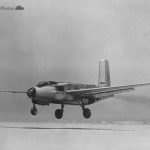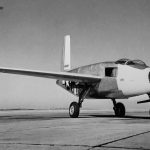Nose view
Left side
XB-43 nose view
Jetmaster in flight
Take off
XB-43
The Douglas XB-43, although being the first U.S. jet bomber, is one of the lesser-known aircraft in the annals of American aviation history. Its development originated from the Douglas XB-42 “Mixmaster,” a piston-engine aircraft with a sleek design, which provided a basis for the jet conversion. In October 1943, the feasibility of replacing the XB-42’s inline piston engines with turbojets was discussed, leading to a change in the contract on March 31, 1944, for the construction and testing of two jet-powered XB-43s.
The conversion to a jet bomber was relatively straightforward: the turbojets were installed in the forward fuselage bays previously occupied by the Allison V-1710 engines, with flush air intakes on the upper fuselage sides and tailpipes routing the exhaust gases to side-by-side openings in the tail. The lower fin of the XB-42 was removed, and the upper fin was enlarged to maintain directional control. The first XB-43 was essentially a modified XB-42 airframe, intended to save time and resources.
However, despite the simplified approach, the first XB-43 did not take flight until May 17, 1946, more than two years after the contract was awarded. The delay was partly due to the post-war slowdown, late delivery of the turbojet engines, and significant teething troubles during ground testing. Notably, in October 1945, the starboard engine suffered a catastrophic failure during a test, causing further delays.
The maiden flight was conducted at Muroc Army Air Base, with test pilot Bob Brush and engineer Russell Thaw at the controls. Before the XB-43’s first flight, there were discussions between the Army Air Forces (AAF) and Douglas about a potential production run of 50 aircraft, with a long-term production rate aimed at 200 B-43s per month. The proposed production versions included a bomber variant with a transparent nose for bomb aiming and an attack variant with heavy armament, including 16 forward-firing .50-caliber machine guns and 36 rockets.
However, by the time the XB-43 flew, the AAF had shifted focus to more advanced designs like the North American B-45, a four-engine jet bomber. Consequently, the XB-43 was relegated to the role of a testbed. Flight trials showed the aircraft was somewhat underpowered, and there were issues such as the Plexiglass nose cracking due to temperature changes, which was later replaced with a plywood cone.
The second XB-43, delivered in May 1947, was used as an engine testbed. It featured a single canopy as proposed for production models and eventually had one of its J35 engines replaced with a General Electric J47. This aircraft continued flying by cannibalizing parts from the first XB-43, which had been damaged in February 1951. The second XB-43 was retired in late 1953.
The XB-43 had the following specifications:
- Span: 71 ft 2 in (21.69 m)
- Length: 51 ft 2 in (15.6 m)
- Height: 24 ft 3 in (7.39 m)
- Wing Area: 563 sq ft (52.305 sq m)
- Empty Weight: 21,775 lb (9,877 kg)
- Loaded Weight: 37,000 lb (16,783 kg)
- Maximum Weight: 39,533 lb (17,932 kg)
- Wing Loading: 65.7 lb/sq ft (320.9 kg/sq m)
- Power Loading: 4.9 lb/lb
- Maximum Speed at Sea Level: 515 mph (829 km/h)
- Cruising Speed: 420 mph (676 km/h)
- Service Ceiling: 38,500 ft (11,735 m)
- Normal Range: 1,100 miles (1,770 km)
- Maximum Range: 2,840 miles (4,585 km)
Despite its pioneering role as the first U.S. jet bomber, the XB-43 remains a footnote in aviation history due to its limited impact and the rapid advancement of jet technology following World War II.





